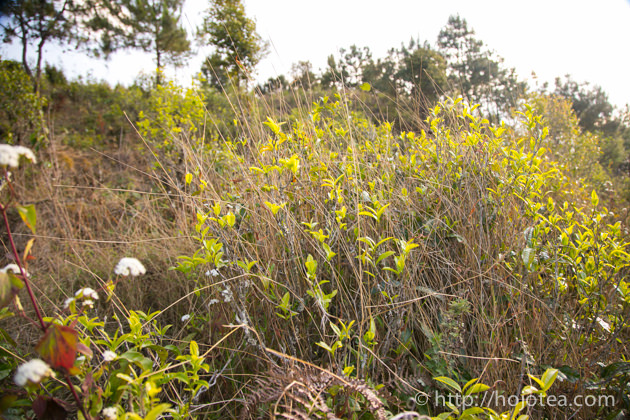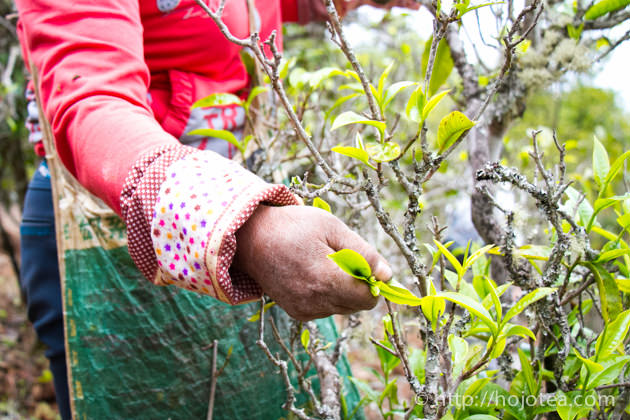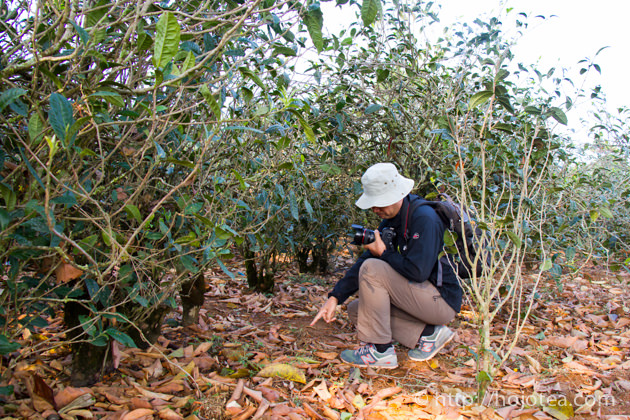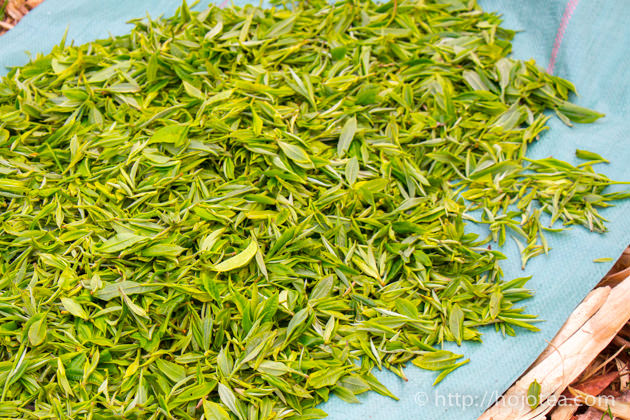- HOME >
- How to choose quality tea
The Relationship Between Greenness of Tea Leaves and Fertilizer
- [2024.03.17] Posted By Akira Hojo
For both tea and vegetables, there’s a common misconception that a deeper green colour indicates better quality and greater health benefits. However, this isn’t always the case.
Natural plants often have a yellowish-green hue rather than a vibrant green.
If you observe wild plants in grasslands or along roadsides during spring, you’ll notice that they typically display a surprising yellow-green colour. Conversely, vegetables grown in cultivated fields exhibit a much richer, deeper green shade, making the field boundaries clearly visible even from a distance. When fertilizer is applied to grass in meadows, the previously yellowish-green vegetation transforms into a lush green, with the fertilized areas noticeably standing out and experiencing significant growth. Similarly, houseplants tend to appear yellowish-green when lacking nutrients, but they turn into a deep green when provided with adequate fertilization.
Tea cultivated without the use of fertilizers often results in smaller leaves with a yellowish-green tint.
This phenomenon is particularly evident in certain regions, such as remote mountain villages in Yunnan Province, where tea bushes are tended to in traditional ways. For the minority communities inhabiting these areas, tea isn’t something they actively cultivate; rather, it naturally thrives in the mountainous terrain. They only clear the undergrowth during the tea-picking season. Throughout the year, no pesticides, fertilizers, or pruning are applied, adhering to a farming method that can be described as simply leaving the tea plants untouched. In Japan, this method is known as natural farming, while in China, it’s referred to as “Sheng-tai Cha”. Tea produced through such methods typically exhibits smaller leaves and a yellow-green coloration.
This agricultural style has been practiced in Yunnan Province for several centuries; however, in recent years, such traditional tea gardens have been on the decline. As these regions gain fame, the demand for their teas surges, consequently driving up prices. In an effort to enhance income, farmers often resort to applying fertilizers, resulting in tea leaves taking on a deeper green hue. Additionally, this practice leads to an increase in leaf size and growth rate, resulting in a significant boost in harvest yield.

Tea gardens maintained in a natural, unattended manner without the use of fertilizers.
Naturally Cultivated Spinach Tends to Have a Yellowish-Green Color
Have you ever seen naturally cultivated spinach? When we think of spinach, we often picture a deep green colour, but spinach cultivated without nitrogen fertilizers surprisingly appears yellow-green. Specifically, we are referring to spinach grown in fields where fertilizers have not been used for over 7-8 years, allowing the soil to completely recover from the effects of fertilizers.
While I don’t have photos to share of naturally cultivated spinach, you can find various images by searching on platforms like Google using keywords such as “spinach” + “natural cultivation” or “spinach” + “no fertilizer.” Natural spinach might be overlooked due to its somewhat yellowish appearance, but its taste is incredibly rich with a sweet aftertaste, making it a memorable culinary experience once you try it.
Plants That Grow Rapidly Often Exhibit a Deep Green Colour
Plants in the natural environment are typically deficient in nitrogen, so when nitrogen fertilizers are added, they quickly absorb nitrogen. This rapid absorption prompts the plants to grow rapidly as well. Consequently, they synthesize chlorophyll, the green pigment responsible for photosynthesis, in abundance, turning into efficient photosynthetic factories. As a result, plants enriched with nitrogen exhibit a very deep green colour, and their leaf surfaces expand to efficiently absorb more light.
The image below shows an area that was once a naturally cultivated tea plantation until a few years ago. Due to the growing popularity of the region, it quickly transitioned into a site cultivated with fertilizers. Contrasting with the naturally cultivated tea plantation above, the tea leaves here are larger, darker in colour, and exhibit numerous surface irregularities. It is believed that plants develop surface irregularities on leaves to increase their surface area, facilitating easier absorption of light.
Rapid Growth Often Results in a Lighter Flavor
Fast-growing crops tend to produce less robust flavours naturally. This is comparable to aquaculture fish raised under accelerated growth conditions, where the tea’s rapid growth often yields a lighter flavor profile. Conversely, tea plants that mature at a slower pace develop firmer leaves and impart an exceptionally rich taste. The superior quality of high-mountain or old-growth tree tea is also attributed to this slower growth rate. When selecting tea, I prioritize gardens that have undergone a slower growth process. Conditions such as no fertilization, no pruning, high-altitude cultivation, old-growth trees, a more northerly latitude, and clayey soil contribute to a slower growth rate, resulting in tea of exceptional quality.
Tea produced without the use of fertilizers often exhibits a yellowish tint overall.
The Role of Magnesium in Chlorophyll and Its Impact on Taste
Chlorophyll, the green pigment in plants, contains magnesium within its molecular structure, along with nitrogen. Magnesium is known for its bitter taste. When magnesium interacts with water, it imparts a bitter and astringent flavor. As mentioned earlier, tea cultivated with fertilizers tends to contain higher levels of chlorophyll. During tea processing, when chlorophyll oxidizes, its molecules break down, releasing the magnesium contained within. While this is a hypothesis, it is possible that slightly oxidized green tea from conventional cultivation (fertilizer-based) may become excessively bitter due to the release of magnesium ions during chlorophyll oxidation and decomposition, impacting the tea’s taste.
In summary, a deep green colour typically signifies vigorous plant growth, often promoted by the use of fertilizer, whether organic or chemical. However, if you’re seeking a tea with a lingering aftertaste, richness, and depth of flavor, it becomes essential for tea leaves to display a yellowish-green hue rather than a vibrant green.
There are exceptions, though; for example, tea cultivated in shaded environments, even if it’s naturally farmed, tends to exhibit a deeper green colour. Due to the limited sunlight in shaded conditions, plants synthesize more chlorophyll, enhancing their ability to absorb sunlight efficiently. The photo above depicts naturally cultivated tea, albeit grown in a shaded area.
Related Articles
How to get the latest update on HOJO?
1. Follow Twitter, 2. Click "Like" on Facebook, and 3. Subscribe in newsletter. You can have the latest tea news from HOJO.
 Subscribe the Newsletter to enjoy the privileges
Subscribe the Newsletter to enjoy the privileges- You may receive a free sample upon purchase, or you may have the priority to purchase special products. So please remember to subscribe our newsletter as well as the social network.
- Myanmar White Tea Bud 2013 from Guo Gan, Myanmar
- We have released a raw Pu-erh tea, 緬甸白芽茶 2013 (Myanmar White Tea Bud 2013), produced by ethnic minorities in t …
- Yong De Wild White Tea 2025 Loose Leaf Limited Release
- We have released Yong De Wild White Tea Loose 2025. For the 2025 harvest, only the loose-leaf type was …
NEW ARTICLES
 Myanmar White Tea Bud 2013 from Guo Gan, Myanmar
Myanmar White Tea Bud 2013 from Guo Gan, Myanmar- We have released a raw Pu-erh tea, 緬甸白芽茶 2013 (Myanmar White Tea Bud 2013), produced by ethnic minorities in t …
 Yong De Wild White Tea 2025 Loose Leaf Limited Release
Yong De Wild White Tea 2025 Loose Leaf Limited Release- We have released Yong De Wild White Tea Loose 2025. For the 2025 harvest, only the loose-leaf type was …
 Experience the True Freshness of Raw Pu-erh : Tang Jia 2025 Loose Leaf Release
Experience the True Freshness of Raw Pu-erh : Tang Jia 2025 Loose Leaf Release- We have released Tang Jia Raw Pu-erh Tea 唐家古樹生茶 2025 Loose Leaf. Among HOJO’s raw pu-erh teas, Tang Jia Raw Pu …
 Yunnan Chun Jian Green Tea from High Mountain Gardens
Yunnan Chun Jian Green Tea from High Mountain Gardens- Yunnan Chun Jian Green Tea is now available. This tea is made from naturally grown leaves harvested from high …
 Limited Loose Leaf Release of 2025 Da Xue Shan Wild Raw Pu-erh Tea
Limited Loose Leaf Release of 2025 Da Xue Shan Wild Raw Pu-erh Tea- We have released the 2025 loose-leaf version of Da Xue Shan Wild Raw Pu-erh Tea. This tea comes from wild tea …
 Discover a New Way to Enjoy Tea: Cooking Rice with Tea
Discover a New Way to Enjoy Tea: Cooking Rice with Tea- Cooking rice with tea is a simple idea, but it brings surprisingly satisfying results. The tea’s flavour seeps …
 2025 Da Xue Shan Wild White Tea Now Available from Yunnan
2025 Da Xue Shan Wild White Tea Now Available from Yunnan- The 2025 harvest of Da Xue Shan Wild White Tea is now available. Crafted from truly wild Camellia taliensis tr …
 Fresh 2025 Yunnan White Tea – Select Your Favourite Lot Before Blending
Fresh 2025 Yunnan White Tea – Select Your Favourite Lot Before Blending- Freshly crafted in Yunnan and just arrived in KL, our new 2025 white tea is now available at our Gardens Mall …
 2024 Dong Shan Raw Pu-erh Tea – Crafted with the Producer for Desired Quality
2024 Dong Shan Raw Pu-erh Tea – Crafted with the Producer for Desired Quality- We have released the 2024 cake of Dong Shan Raw Pu-erh Tea. Earlier, we offered the loose-leaf version from th …
 Development of Firewood Roasted Hojicha Using Naturally Grown Tea from Yunnan
Development of Firewood Roasted Hojicha Using Naturally Grown Tea from Yunnan- We are currently staying in Yunnan Province for tea production. As the season nears its end, tea trees with pa …
Category
- New Arrival at HOJO Online Shop
- Featured Articles
- Newsletter
- Types of Tea
- Origin of Tea
- Teapot and Tea Equipment
- Tea Column
- How to enjoy tea
- Tea Processing
- How to choose quality tea
- Tea constituents and functional effect
- Safety of Tea
- Foods
- Tea Business Operation
- Hobby and Outdoor Activity
- Ranking of Tea
- Video
- FAQ
- Media Release
Profile

- AKIRA HOJO
- I invite you to experience my tea selections.I was born in Nagano, Japan. In university, I studied agricultural chemistry, and I have the master degree in food science. I worked in Japanese food industry for 10 years. I involved in R&D, QC and QA. As a factory manager, I implemented ISO9000 series and managed the factory.
- The Art of Tea Magazine
- We posted the article on “The Art of Tea Magazine No.9, the magazine is published in Taiwan. We featured …
- New Straits Times
- The Malaysian National Newspaper, New Straits Times featured HOJO Tea on 17-Oct-2007.
Shop Info

Address:Lot No. T-215, 3rd Floor, The Gardens Mall, Mid Valley City, Lingkaran Syed Putra, 59200 Kuala Lumpur
Tel: +603-2287-4537
Business Hour: 10am to 10pm






















